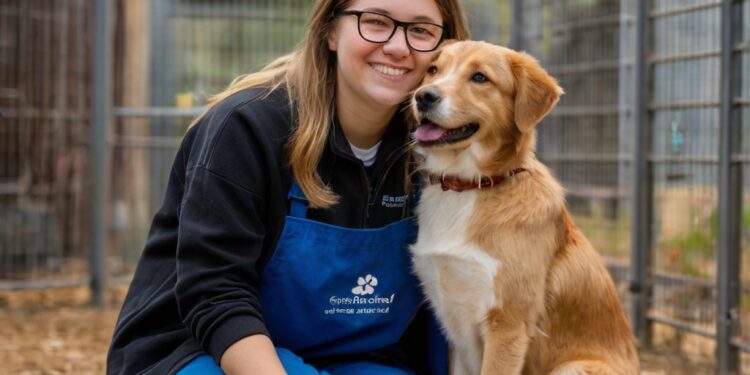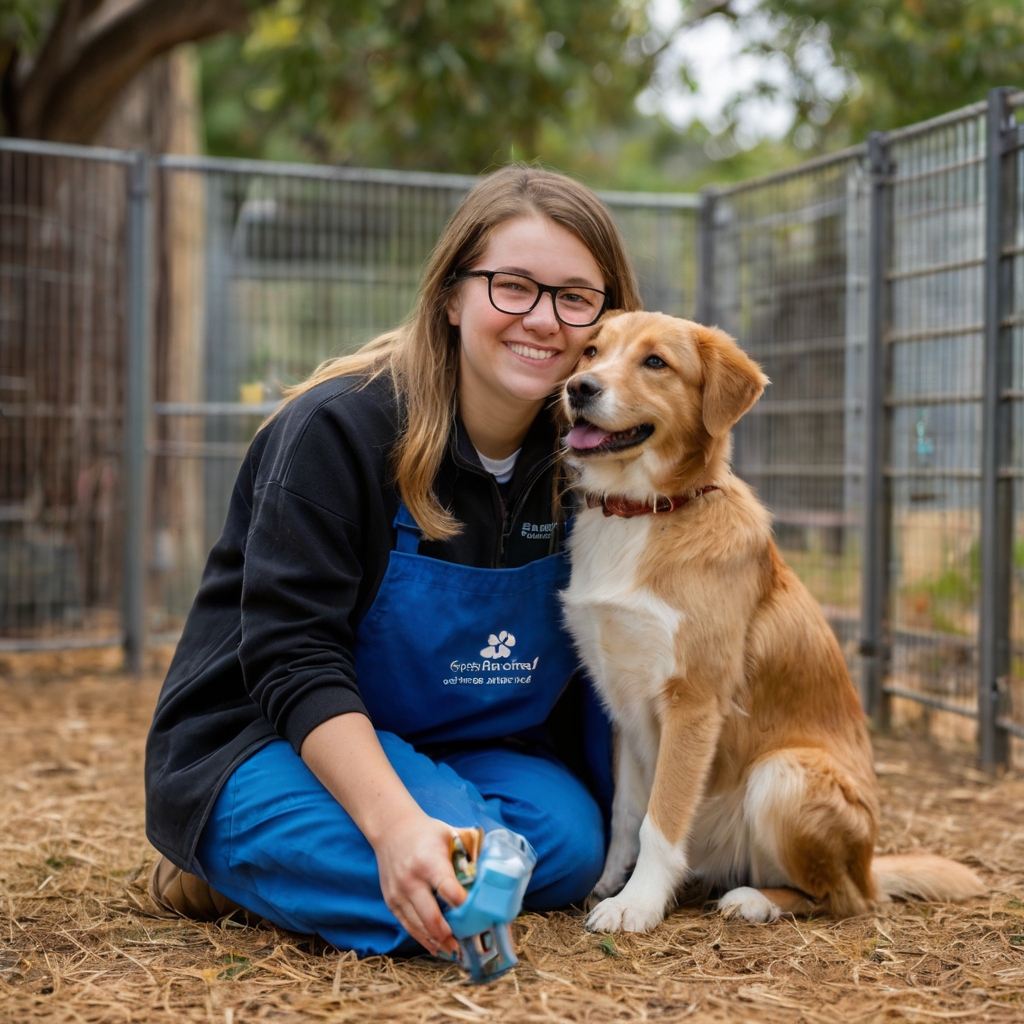Animal Shelter Volunteer

Millions of animals end up in shelters throughout the United States each year. These animals depend on dedicated shelter volunteers to provide care, comfort and friendship. Shelter volunteers are the foundations of daily operations and make the most important impact on homeless pets’ lives.
Animal lovers can find many ways to help – from local shelter programs to specialized roles at organizations like the Humane Society. People interested in volunteering will find opportunities in major cities like NYC and San Diego, or right in their own neighborhoods. The great news is that shelters welcome volunteers of all ages. Many programs allow young people to participate, and some shelters let kids as young as 12 or 13 get involved.
This detailed guide covers everything aspiring volunteers should know about working with shelter animals. Readers will learn about basic requirements, training needs, safety rules and the different positions they can explore.

Table of Contents
- 1 Essential Requirements for Animal Shelter Volunteers
- 2 Understanding Different Volunteer Positions
- 3 Comprehensive Training Process
- 4 Safety Protocols and Best Practices
- 5 Working with Different Animal Types
- 6 Here are some FAQs about becoming an animal shelter volunteer:
- 6.1 How old do you have to be to volunteer at an animal shelter?
- 6.2 How to start an animal rescue with no money?
- 6.3 Where can a 14-year-old volunteer?
- 6.4 How old do you have to be to work in Pets at Home?
- 6.5 How old do you have to be to work in a zoo?
- 6.6 How old do you have to be to own a pet?
- 6.7 How much is a pet plan?
- 6.8 How much does each pet cost?
- 6.9 How long does a pet plan last?
- 6.10 Is pet insurance expensive?
- 6.11 Is it okay to not have pet insurance?
- 6.12 How much does dog food cost?
- 6.13 Is lifetime pet insurance worth it?
- 6.14 Can you volunteer at Battersea Dogs Home?
- 6.15 Where can a 13-year-old volunteer?
Essential Requirements for Animal Shelter Volunteers
Animal shelters need volunteers who meet specific criteria to keep both volunteers and animals safe. These requirements help people prepare for their dedication to animal welfare.
Age and physical requirements
Animal shelters maintain strict age requirements for their volunteers. You need to be 16-18 years old to volunteer independently. Some shelters let younger people help through special programs, and kids aged 12-15 can volunteer with their parents. Your physical capabilities play a key role in safe and effective animal care. Volunteers should be able to:
- Stand and walk for up to three hours
- Lift and carry up to 20 pounds
- See clearly both up close and at a distance
- Handle tasks that need bending and reaching
Time commitment expectations
Quality animal care depends on consistent volunteer schedules. Most shelters ask for a minimum of 8 hours per month, while others need 6 hours per month for at least six months. Students who need community service hours should complete 30 hours before the shelter will verify their service.
Required documentation and background checks
Proper documentation helps shelters ensure reliable volunteers and animal safety. You’ll need these essential documents:
A valid photo ID (driver’s license, passport, or school ID) Proof of eligibility (social security card or birth certificate) Completed volunteer application forms Signed liability waivers
Background checks have become standard practice at animal shelters. Many locations screen criminal histories, especially for roles with direct animal care or administrative duties. People with certain convictions cannot volunteer, particularly those with animal cruelty or violent crime records. Some shelters require fingerprinting through live scan, and results can take 3 to 30 days.
Volunteers under 18 need extra paperwork, such as parental consent forms. Some shelters also want parents or guardians to attend orientation sessions. These measures create a safe environment for young volunteers and the animals they help care for.
Understanding Different Volunteer Positions
Animal shelters welcome volunteers with different skills, interests, and time commitments. The opportunities range from hands-on animal care to administrative support, and each role helps keep the shelter running smoothly.
Direct animal care roles
Direct animal care volunteers are the life-blood of shelter operations. They work closely with shelter pets to provide care and socialization. These roles include dog walking, cat socialization, and simple training activities. Volunteers help teach shelter dogs simple obedience and provide enrichment activities. The team assists with cat socialization, feeding, and keeps living spaces clean while helping cats feel at home in the shelter environment.
Administrative support positions
A dedicated team of administrative volunteers powers every successful shelter operation. These team members handle important tasks such as:
- Answering phones and managing customer service
- Processing adoption applications
- Maintaining inventory and ordering supplies
- Assisting with data entry and filing
Administrative volunteers are a vital part of coordinating with staff to optimize operations and help develop departmental goals. Their work makes daily operations smooth and lets direct care volunteers focus on animal welfare.
Special events and fundraising opportunities
Special events and fundraising initiatives give volunteers a chance to support animal shelters while connecting with the community. Popular fundraising activities include:
- Walk-a-thons and community runs with shelter dogs
- Silent auctions and raffle events
- Pet photography sessions
- Supply drives and donation stations
These events raise needed funds and boost community awareness about shelter needs. Volunteers can organize festivals, work with local businesses for sponsorships, and run social media campaigns to promote adoption events. Special events usually take 45-60 minutes of volunteer time and include options for both in-person and virtual participation.
Through these varied positions, volunteers add by a lot to shelter operations while learning valuable skills in animal care, event management, and community outreach. Each role, whether direct care, administrative, or event-based, helps build a detailed support system for sheltered animals.
Comprehensive Training Process
Animal shelter volunteers need proper training to succeed and keep animals safe. Most shelters have a complete training program that starts with orientation and builds toward specialized skills.
Original orientation sessions
New volunteers start their trip with a required orientation session. These sessions come in two formats: in-person meetings or online presentations. Volunteers must attend an in-person session or watch the online orientation video, read the volunteer handbook, and pass an assessment test. People who choose the online option usually get a quick in-person tour during their first day. Orientation sessions take about an hour and cover everything about the facility, available programs, and future goals.
Hands-on training modules
After orientation, volunteers get practical training for their chosen roles. The hands-on training has:
- Simple daily tasks training
- Animal handling instruction
- Role-specific practical experience
- Shadowing experienced volunteers
Volunteers need two to five hours of hands-on training before they can work on their own. Dog walking and other specialized roles need extra training sessions about animal behavior and safety protocols.
Ongoing education requirements
Continuing education is crucial to the volunteer experience. Many shelters ask volunteers to complete specific certifications and ongoing training, such as:
Fear Free Shelters certification and trauma-informed sheltering courses. Advanced volunteers can learn more skills and take on bigger responsibilities. Some facilities let volunteers advance through different expertise levels. These advanced roles need higher commitment levels and specialized training modules.
Many shelters give volunteers access to online libraries and education opportunities to help them learn more. Ongoing training ensures shelter animals get quality care and gives volunteers valuable skills in animal welfare.

Safety Protocols and Best Practices
Safety protocols are the foundations of responsible animal shelter volunteering. These protocols protect caregivers and animals under their supervision. A complete understanding of these guidelines will give a secure environment to everyone involved in shelter operations.
Personal protective equipment usage
PPE serves as the first line of defense against workplace hazards in animal shelters. Volunteers must use these essential PPE items:
- Disposable gloves for handling animals and cleaning tasks
- Protective eyewear when working with cleaning chemicals
- Face masks for disease prevention
- Surgical gowns or protective clothing
- Closed-toe shoes with non-slip soles
The core team must train volunteers about PPE usage and correct procedures to put on and remove equipment. This training maximizes protection and prevents cross-contamination between different shelter areas.
Disease prevention measures
Disease prevention in animal shelters needs an integrated approach that focuses on sanitation and proper handling procedures. Looks can be deceiving when it comes to cleaning. An area might appear clean, but proper disinfection is vital to remove pathogens.
Shelters typically divide areas based on contamination risk:
- High-Contact Areas: Surfaces that multiple animals touch need frequent disinfection
- High-Risk Areas: Spaces used by juvenile or unvaccinated animals need thorough sanitization between uses
- Low-Contact Areas: Surfaces with minimal animal contact need regular cleaning
Emergency response procedures
Emergency preparedness plays a vital role in maintaining shelter safety. A well-laid-out emergency response plan has clear protocols for situations ranging from medical emergencies to natural disasters. Emergency response includes these key components:
- Immediate notification of supervisors about any incidents
- Documentation of all accidents or injuries
- Knowledge of emergency exit locations
- Access to first aid supplies and emergency contact information
- Understanding of evacuation procedures
Volunteers should know the shelter’s emergency communication systems, including cellular phones, radios, or walkie-talkies. This equipment helps quick response times during critical situations and maintains clear communication channels between staff members.
Regular training and updates make these safety protocols effective. Shelters review their safety practices periodically, especially with at-risk animal populations. Proper adherence to these guidelines creates a safer environment for volunteers and animals in their care.
Working with Different Animal Types
Animal shelters need volunteers who understand the unique requirements of different animals to provide proper care. U.S. shelters take in about 6.3 million companion animals each year. Volunteers must be ready to work with animals of all types and conditions.
Handling dogs and cats
Dogs and cats need different handling approaches based on their natural behaviors and stress responses. Dogs create strong bonds because they are social animals. They might experience isolation stress in shelter environments. A volunteer should watch a dog’s body language carefully because stressed animals often show defensive behaviors or anxiety.
Cats need a more measured and patient approach. Their true carnivorous nature combines predatory and prey instincts. This makes them extra sensitive to changes in their environment. Volunteers should follow these guidelines when handling cats:
- Provide hiding opportunities to reduce stress
- Use quiet, gentle movements
- Allow the cat to initiate interaction
- Maintain consistent handling routines
Special needs animal care
Special needs animals make up much of shelter populations. These animals often wait four times longer than others to find homes. They need specialized care and attention in several categories:
- Physical Disabilities: Including missing limbs, paralysis, or mobility issues
- Chronic Medical Conditions: Such as diabetes, allergies, or cancer
- Behavioral Challenges: Including separation anxiety or situational fears
- Age-Related Issues: Affecting senior pets with declining senses
Special needs animals adapt surprisingly well to their circumstances. A three-legged dog runs and plays normally. Blind or deaf pets learn to use their other senses effectively. Patient support and regular veterinary care will give these animals the best chance at a good life.
Wildlife considerations
Most shelter volunteers work with domestic animals, but wildlife encounters happen during rescue operations or intake procedures. Wildlife interactions need specific protocols that keep both humans and animals safe.
Volunteers should follow these guidelines during wildlife situations:
- Maintain appropriate distance from aggressive animals
- Contact state wildlife agencies for protected species
- Use proper protective equipment
- Follow specific shelter protocols for wildlife encounters
- Document all wildlife interactions
Wild animals play vital roles in natural ecosystems but can damage property or create safety risks. Homeowners can resolve wildlife problems by modifying habitats. Simple changes like trimming trees and shrubs make areas less attractive to unwanted wildlife.
Community cat program volunteers often see wildlife species sharing spaces with feral cats. These encounters usually involve possums, raccoons, and skunks during feeding times. Colony managers should schedule their activities early in the day. This helps avoid peak wildlife activity periods that typically happen at night.
Volunteers who understand and respect each animal’s unique needs can deliver better care while staying safe. Proper training and safety protocols combined with this knowledge will give both volunteers and animals a positive experience.
Helping at animal shelters lets you directly affect homeless pets’ lives. Volunteers take on many roles – they provide direct animal care, handle office work, and coordinate special events. These services keep shelters running smoothly.
Good shelter volunteers know they must meet simple requirements and follow safety rules. They complete thorough training programs to learn their roles. These people work with animals of all types, handle emergencies, and follow strict steps to prevent diseases.
A volunteer’s dedication to animal welfare goes beyond daily care tasks. People who help at shelters learn valuable skills while creating better futures for the animals. Their efforts boost adoption chances and help shelters of all sizes maintain excellent care standards nationwide.
Every bit of help, big or small, creates better lives for millions of animals waiting to find homes. The right preparation, constant learning, and focus on safety make these programs work well for both volunteers and animals.

